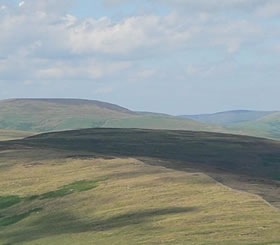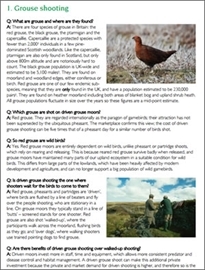 By Andrew Gilruth, GWCT Communications Director
By Andrew Gilruth, GWCT Communications Director
1) Shooting at Langholm
The RSPB has recently stated here that the data shows: “hen harriers can recover in the presence of red grouse recovery to a level which once supported driven shooting, albeit the agreed target density for driven shooting was not met.”
If you read the data here (which the partners, including the RSPB, signed off) you will see (page 19) that grouse counts in 2014 were similar to when they were last shot in 1996, but there were good reasons why the partnership decided it was not feasible to shoot.
All the partners at Langholm, including the RSPB, agreed that shooting could not restart because the grouse population was not high enough to sustain it – we would have been shooting into the grouse ‘breeding stock’ population.
This low population was apparently the result of high levels of predation, with 78% of grouse found dead showing signs of being killed by raptors. The project’s scientists had modelled this unsustainable harvest, and there was historical evidence that such a grouse population could not sustain shooting from the early 1990s (see the falling line on page 19) when shooting at Langholm had to be suspended.
2) Heather burning
The partners at Langholm, including the RSPB, supported heather burning and reported on its ability to help restore habitat in 2014 here (p15, 16, 28, 36, 43, 44).
Today, we are disappointed to see that parts of the RSPB are repeating a simplistic position about heather burning and ‘damage’ here. This is despite a recent, very helpful, high-level scientific debate between RSPB scientists (amongst others) and the wider research community (from the UK, the Netherlands, Italy, Portugal, Norway and the USA) agreeing that the evidence does not verify all the claims here.
There remains contradictory evidence about the actual positive or negative impact of burning when longer timescales are taken into account1,2. More research is needed – much of it over the medium to long term.
3) Grouse shooting - the way forward
The RSPB suggests here that there are three options:
1. No change
2. License
3. Ban
We suggest there is a fourth, already under way:
4. Continuous improvement
Grouse moor managers have shown they are prepared to change practices if there are ecological advantages. This has been demonstrated in the eight workshops organised this year by Natural England with moorland managers. On 190 grouse moors, managers have been reversing the damage of grant-aided farming drainage schemes from the 1960s and 70s.
Everyone accepts that we need to test and trial solutions. Langholm is a trial site. These are particularly important where the evidence is not clear (see burning above). This is why Natural England has been asked by Defra to trial its hen harrier recovery plan here.
These trials allow us to find the best balance between environmental outcomes and being able to maintain an economic land use – that is exactly what Natural England’s outcomes approach is designed to do here.
Get your FREE guide to grouse shooting and moorland management
 What's inside your FREE guide
What's inside your FREE guide
✓ Grouse shooting
✓ Conservation on grouse moors
✓ Heather burning
✓ Moorland drainage
✓ Disease control
✓ Upland predator control
✓ Hen harriers and red grouse
✓ Mountain hares and red grouse
✓ Alternative moorland use
✓ Commonly heard criticisms of driven grouse shooting
Get your FREE guide to grouse shooting and moorland management >
References
1. Brown L, Holden J, Palmer S. Effects of moorland burning on the ecohydrology of river basins. Key findings from the EMBER project. 2014.
2. Clay GD, Worrall F, Aebischer NJ. Carbon stocks and carbon fluxes from a 10-year prescribed burning chronosequence on a UK blanket peat. Soil Use Manag 2015; 31: 39–51